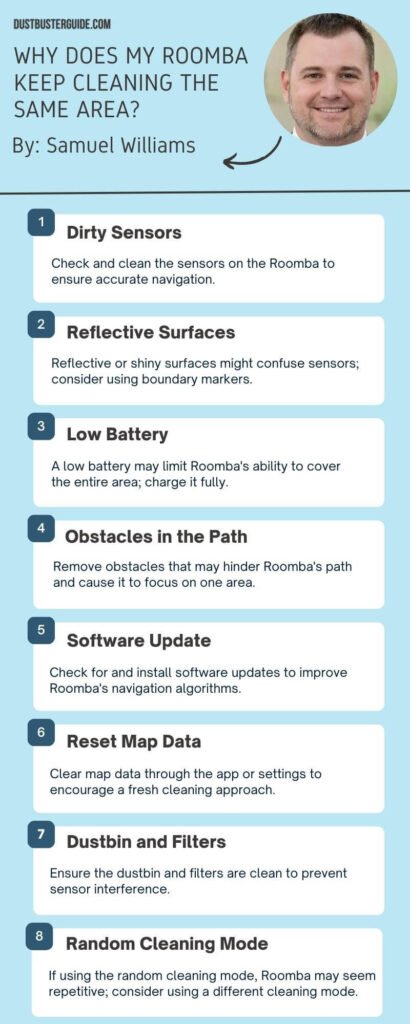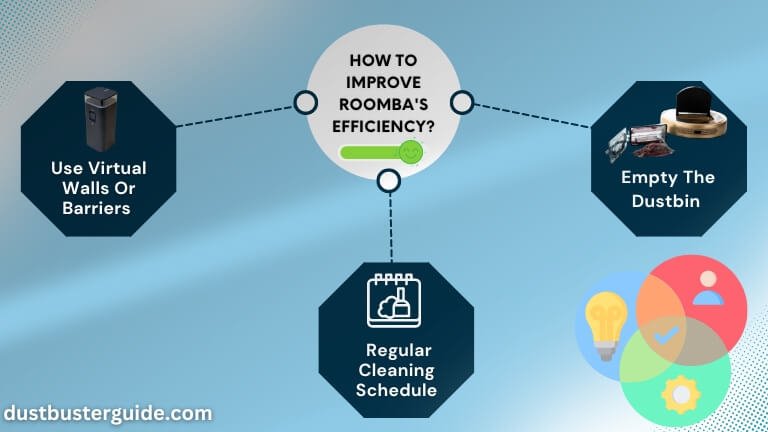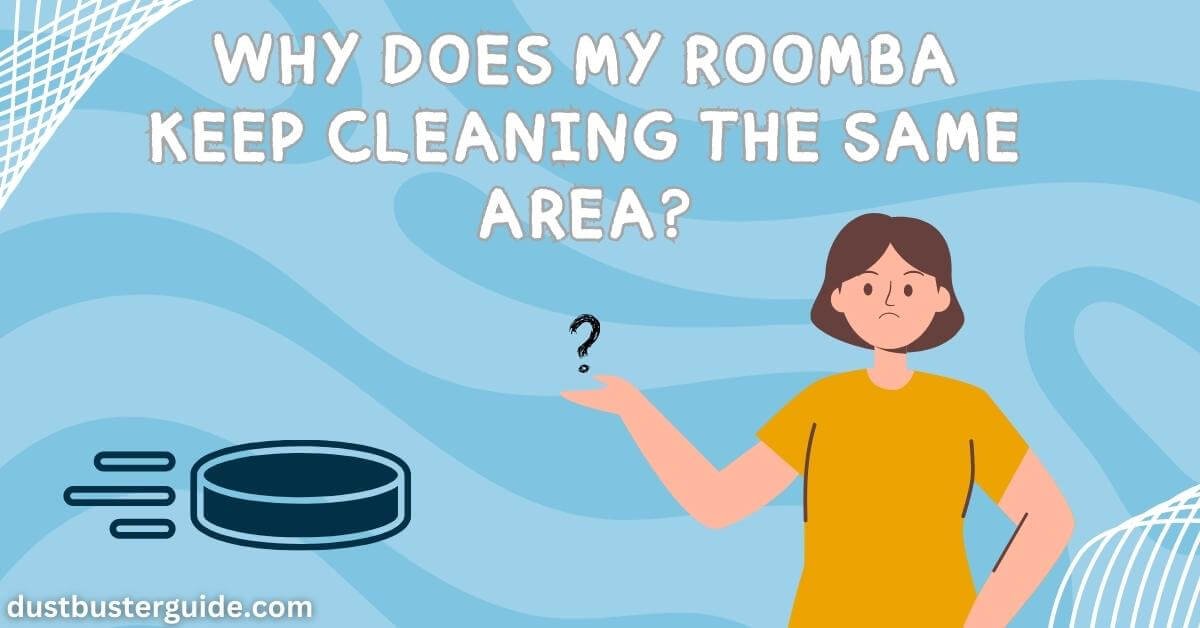Ever marveled at your Roomba’s peculiar cleaning routine, as it mysteriously circles back to the same spot? If you’ve ever wondered, why does my Roomba keep cleaning the same area? you’re not alone in this robotic enigma.
Imagine this: your dependable cleaning assistant is seemingly stuck in a loop, giving extra attention to a specific zone. In just a few lines, the answer surfaces: your Roomba might be grappling with obstacles or navigation challenges, causing it to linger in familiar territory.
But before you dismiss it as mere machine caprice, join us on this exploration. We’ll navigate through potential solutions, ensuring your Roomba becomes the versatile cleaning virtuoso you envisioned, with a knack for covering all corners of your living space!
Why Does My Roomba Keep Cleaning The Same Area – Reasons
Are you wondering why your Roomba keeps going over the same spots again and again? There are a few reasons why your Roomba might be getting stuck in a cleaning loop.
One possible reason is that there are obstacles in the area that the Roomba is unable to navigate around. These obstacles could be furniture, cords, or other objects that are blocking the Roomba’s path. When the Roomba encounters an obstacle, it may try to clean around it, but if it is unable to do so, it may continue to go over the same spot in an attempt to clean it.
Another reason why your Roomba may be cleaning the same areas is that the room may have a layout or furniture arrangement that is confusing to the Roomba’s navigation system. Roombas use sensors and algorithms to navigate and map out the rooms they are cleaning. However, if the room has a complex layout or if there are multiple areas that look similar, the Roomba may have difficulty determining where it has already been cleaned and where it still needs to be cleaned. As a result, it may end up going over the same areas repeatedly.

How To Troubleshoot Roomba Keeps Cleaning The Same Area
Explore effective troubleshooting techniques to address the issue of your Roomba repeatedly vacuuming a specific spot.
- When faced with this problem, the first step is to check and clean the sensors on your Roomba. Dust, dirt, or debris can accumulate on the sensors, causing them to malfunction and perceive the same spot as dirty repeatedly. Use a soft cloth or a cotton swab to gently wipe the sensors and ensure they’re free from any obstructions.
- Additionally, make sure that the sensors aren’t covered by any furniture or objects that could interfere with their functionality.
- Another troubleshooting technique is to reset your Roomba. Sometimes, a simple reset can solve the issue of the Roomba cleaning the same area over and over again. To reset your Roomba, press and hold the ‘Clean’ button for about 10 seconds until you hear a tone. This will restart the Roomba’s system and may resolve any software glitches that were causing the repetitive cleaning behavior.
- Additionally, try relocating the Home Base. If the Home Base is placed too close to the problematic area, the Roomba may get confused and continuously navigate back to that spot. Move the Home Base to a different location and see if the Roomba starts cleaning other areas more effectively.
By following these troubleshooting techniques, you can hopefully resolve the issue of your Roomba repeatedly cleaning the same area and enjoy a more efficient and thorough cleaning experience.
Does My Roomba’s Cleaning Pattern Change Over Time
Discover how the cleaning pattern of your trusty Roomba can evolve and adapt over time. As your Roomba spends more time cleaning your home, it begins to learn and understand the layout of your space.
Initially, it may appear that your Roomba is cleaning the same area repeatedly, but rest assured, it’s actually mapping out the most efficient cleaning path.
One interesting fact is that Roomba uses a combination of sensors and algorithms to navigate and clean your home. These sensors help it detect obstacles, walls, and furniture, allowing it to create a mental map of your space. As it continues to clean, it analyzes this map and adjusts its cleaning pattern accordingly.
This means that over time, your Roomba will develop a more efficient and thorough cleaning routine, ensuring that no area is left untouched.
Another fascinating aspect is that Roomba is equipped with a technology called iAdapt, which enables it to adapt its cleaning pattern based on the layout of your home. It can detect different types of surfaces, such as carpet or hardwood, and adjust its cleaning mode accordingly. It also recognizes high-traffic areas and spends more time cleaning those spots.
This intelligent adaptation ensures that your Roomba maximizes its cleaning efficiency and provides a deeper clean over time.
Your Roomba’s cleaning pattern does change and improve over time. Its ability to learn and adapt to your home’s layout ensures that it becomes more efficient and thorough with each cleaning cycle. So, if you notice your Roomba seemingly cleaning the same area repeatedly, rest assured that it’s just fine-tuning its cleaning routine for optimal performance.
How Can I Reset My Roomba’s Cleaning Pattern
Resetting your Roomba’s cleaning pattern is a simple and effective way to refresh its approach to tidying up your home. Sometimes, the Roomba can get stuck in a cleaning loop and keep going over the same area repeatedly. This can be frustrating and inefficient, as it may not cover all the areas that need cleaning.
By resetting the cleaning pattern, you can ensure that your Roomba explores new areas and reaches every nook and cranny of your home.
To reset your Roomba’s cleaning pattern, you can follow a few easy steps. First, locate the ‘Clean’ button on your Roomba. Press and hold this button for about 10 seconds until you hear a tone. This indicates that the cleaning pattern has been reset. Once the tone is heard, release the button and let your Roomba sit for a few moments.
After a short pause, you can restart your Roomba by pressing the ‘Clean’ button again. This will initiate a new cleaning cycle with a refreshed pattern, allowing your Roomba to clean your home more effectively.
Resetting your Roomba’s cleaning pattern can help alleviate the issue of repeatedly cleaning the same area. By following a few simple steps, you can ensure that your Roomba explores new territories in your home and covers all the areas that need cleaning.
So, give your Roomba a fresh start and enjoy a more efficient cleaning experience.
Pros And Cons Of Resetting Roomba’s Cleaning Pattern
How To Improve Roomba’s Efficiency
Enhance your Roomba’s performance by implementing simple strategies to maximize efficiency. By following these tips, you can ensure that your Roomba cleans your home more effectively and efficiently.

- Firstly, consider the layout of your home and make sure that it’s optimized for your Roomba’s cleaning pattern. Clear any clutter or obstacles that may impede its movement, such as loose cables or small objects on the floor.
- If there are areas you don’t want your Roomba to clean, use virtual walls or barriers to restrict its access. This will prevent the Roomba from wasting time and energy cleaning unnecessary spaces.
- Secondly, establish a regular cleaning schedule for your Roomba. Set it to clean at times when you’re not at home or when you’re least likely to be disturbed. This will allow the Roomba to clean without interruptions, maximizing its efficiency.
- Additionally, make sure to empty the dustbin after each cleaning session. A full dustbin can hinder the Roomba’s suction power and reduce its cleaning effectiveness. By keeping the dustbin empty, you ensure that the Roomba can continue cleaning efficiently without any obstructions.
By implementing these strategies, you can improve your Roomba’s efficiency and ensure that it cleans your home more effectively. Take the time to optimize your home’s layout and establish a regular cleaning schedule for your Roomba.
With these simple steps, you can maximize the performance of your Roomba and enjoy a cleaner home with less effort.
What Environmental Factors Influence My Roomba’s Cleaning Performance
Optimize your Roomba’s cleaning efficiency by understanding the environmental factors that affect its cleaning behavior. By taking these factors into consideration, you can ensure that your Roomba is able to clean effectively and efficiently.
- One important environmental factor to consider is the layout of your home. Roombas use infrared sensors to navigate and detect obstacles, so if your furniture is arranged in a way that creates narrow passages or tight corners, it may cause the Roomba to repeatedly clean the same area. To improve its efficiency, make sure that there’s enough space for the Roomba to maneuver and avoid any obstacles.
- Another factor to consider is the presence of clutter. If there are a lot of objects on the floor, such as toys, cables, or loose clothing, the Roomba may have difficulty navigating around them and may spend more time trying to clean a specific area. To address this, it’s important to keep the floor clear of any clutter before running the Roomba. This will allow it to move freely and clean efficiently without getting stuck.
- Additionally, the type of flooring in your home can also affect the Roomba’s cleaning behavior. Different floor surfaces, such as carpet, hardwood, or tile, may require different cleaning settings or brush adjustments. It’s important to check the manufacturer’s recommendations for your specific Roomba model and adjust the settings accordingly to ensure optimal cleaning performance.
Understanding and addressing the environmental factors that affect your Roomba’s cleaning behavior can greatly improve its efficiency. By considering factors such as the layout of your home, the presence of clutter, and the type of flooring, you can optimize your Roomba’s cleaning performance and ensure that it effectively cleans all areas of your home.
How Do Sensors Impact My Roomba’s Cleaning Efficiency
Improve the efficiency of your Roomba’s cleaning patterns by understanding the crucial role of sensors and their calibration and maintenance.
Sensors are the eyes and ears of your Roomba, allowing it to navigate and clean your home effectively. However, if the sensors are not properly calibrated or maintained, it can result in the Roomba repeatedly cleaning the same area.
Calibration is the process of adjusting the sensors to ensure accurate readings and optimal performance. Over time, the sensors may become misaligned or lose their calibration due to regular use or accidental bumps. To calibrate the sensors, refer to Roomba’s user manual for specific instructions. This usually involves placing the Roomba on a flat surface and initiating the calibration mode.
By regularly calibrating the sensors, you can ensure that your Roomba accurately detects and navigates around obstacles, preventing it from getting stuck or going over the same spot repeatedly.
In addition to calibration, proper maintenance of the sensors is essential for efficient cleaning patterns. The sensors can accumulate dust, dirt, and debris during operation, which can interfere with their functionality. Regularly cleaning the sensors with a soft, dry cloth or a brush can help remove any build-up and ensure their accuracy. It’s also important to check for any physical damage to the sensors and replace them if necessary.
By taking the time to calibrate and maintain the sensors, you can optimize your Roomba’s cleaning performance and prevent it from repeatedly cleaning the same area.
How To Train Your Roomba
To get the most out of your Roomba, it’s important to train it to follow the most efficient cleaning routes. By teaching your Roomba the optimal cleaning routes, you can ensure that it covers every area of your home and doesn’t keep cleaning the same spot repeatedly.
- One way to train your Roomba is by using virtual walls or barriers to create boundaries. These barriers can be physical objects or virtual ones that you set up using Roomba’s companion app. By strategically placing these barriers, you can guide your Roomba to clean specific rooms or areas first before moving on to the next. This way, it won’t waste time going back and forth in the same spot.
- Another method to train your Roomba is by using the ‘lighthouse’ feature that comes with some models. These lighthouses act as beacons and can be used to guide your Roomba to different areas of your home. By placing the lighthouses strategically, you can direct your Roomba to clean one room completely before moving on to the next. This method is particularly useful for larger homes or homes with multiple levels.
- Additionally, you can also manually guide your Roomba during its initial cleaning runs. By physically moving it to different spots in the room and letting it continue from there, you can help it create a more efficient cleaning route. Over time, your Roomba will learn from these initial runs and be able to navigate your home more effectively on its own.
Does Roomba Know When The Room Is Clean?
Roomba vacuums are equipped with a combination of sensors and algorithms designed to navigate and clean a room effectively. While Roombas don’t have a specific sensor to detect cleanliness, they use various sensors, such as dirt detection sensors, cliff sensors, and infrared sensors, to navigate and assess the environment. Some Roomba models also have a feature called “Dirt Detect,” which allows the Roomba to identify dirtier areas and focus more on cleaning those spots.
However, Roombas do not have a subjective understanding of cleanliness like humans do. They rely on their sensors and programming to detect obstacles, map the environment, and adjust their cleaning patterns. Once a Roomba completes its cleaning cycle or when its battery is low, it typically returns to its docking station. Users can manually initiate the cleaning process or schedule automatic cleaning sessions, ensuring that the Roomba covers the designated areas within a room.
Conclusion
So your puzzle why does my Roomba keep cleaning the same area? is now solved. The repetition of Roomba cleaning can be frustrating, but there are reasons for it. Environmental factors, cleaning patterns, and sensors can contribute to the issue. Troubleshoot by resetting patterns or training Roomba for optimal routes.
The Roomba’s cleaning pattern may improve over time as it learns from your home’s layout. Consider environmental factors like lighting and furniture placement for better navigation. Properly calibrate and maintain Roomba’s sensors. Optimizing its cleaning efficiency will save time and effort. Don’t give up on your Roomba; troubleshooting and adjustments can make it a valuable cleaning companion.
FAQs
Can I manually change my Roomba’s cleaning pattern?
Yes, you can manually change your Roomba’s cleaning pattern. Just use the provided remote or the mobile app to select a different cleaning mode or set up virtual walls to guide it.
How often should I reset my Roomba’s cleaning pattern?
We should reset our Roomba’s cleaning pattern whenever we notice it repeatedly cleaning the same area. This will help it navigate our home more efficiently and ensure that all areas are properly cleaned.
What are some tips to improve my Roomba’s efficiency?
To improve our Roomba’s efficiency, we can try a few things. First, ensure the room is clear of obstacles. Second, regularly clean the Roomba’s sensors and brushes. Lastly, consider using virtual walls or barriers to guide its cleaning path.
Are there any environmental factors that can affect my Roomba’s cleaning behavior?
Yes, there are environmental factors that can affect our Roomba’s cleaning behavior. It may get stuck on obstacles, struggle with dark or reflective surfaces, or be affected by strong lighting conditions.
How do sensors play a role in my Roomba’s cleaning patterns?
Sensors are crucial in determining Roomba’s cleaning patterns. They help detect obstacles, map the room, and navigate efficiently. Without them, Roomba may not be able to recognize when it has already cleaned a specific area.
Why is my Roomba not cleaning the whole house?
If your Roomba is not cleaning the whole house, check for obstacles, low battery, or issues with room layout. Consider using Virtual Walls to guide its path and ensure the environment is suitable for its navigation.
Can Roomba clean in the dark?
Roomba can clean in low-light conditions, but total darkness may impact its performance as it relies on sensors and cameras. Some models with advanced sensors may navigate in low light, but optimal cleaning is achieved in well-lit environments.
External Resources
- Psychoacoustic Analysis Of Vacuum Cleaner Noise – MDPI
- Design, Dirt And Disposal: Influences On The Maintenance Of Vacuum Cleaners – ScienceDirect
- Typical Household Vacuum Cleaners: The Collection Efficiency And Emissions Characteristics For Fine Particles – Taylor & Francis Online
- The Design Methodology To Develop New-Generation Universal-Motors For Vacuum Cleaners – IEEE Xplore

